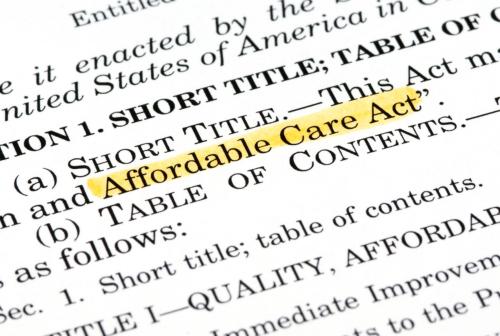In the weeks leading up to the midterm elections, just 14 percent of Americans approve of how Congress is handling its job.1 Up only 5 percent from its all-time low last November, trust in America’s legislative body has been on a steady decline over the past decade.2
A recent New England Journal of Medicine article suggests members of Congress may not be the only group suffering from low public approval. Only 34 percent of Americans expressed “great confidence” in the medical profession, and only 23 percent expressed “significant confidence” in the healthcare system. It is important to note that a majority of Americans are completely or very satisfied with their last physician visit; and a high proportion rate their physician’s honesty and commitment to ethical standards as very high (56 percent) or high (59 percent).
The study’s authors propose that a relationship exists between the low confidence in the leaders of the medical profession and in the health care system. They suggest clinical leaders take a firmer stand on health policy reform, especially as they relate to high costs. A Gallup survey confirms that most Americans (73 percent) are confident doctors can make the right choices when it comes to health care reform. As highlighted by Brookings’ Merkin Initiative on Payment Reform and Clinical Leadership, many clinical trailblazers have already started to address health care payment and delivery system issues.
We offer the following examples of where physicians have been instrumental in leading health system reform to improve the overall value of patient care.
Population Level Care Redesign
In recognition of the failings of the current system—with respect to non-reimbursed high value care, increasing medication costs, etc.—many physicians have taken matters into their own hands to transform the care patients receive. For example, Dr. Elizabeth Woods of Boston Children’s Hospital recognized that efforts, such as patient-centered education and indoor environmental remediation of mold, pests, and harmful cleaning chemicals, could prevent a significant number of unnecessary emergency department visits and hospitalizations among children with asthma. These efforts resulted in the Hospital’s Community Asthma Initiative; a program that provides these services at no cost to families with high-risk asthmatic children. Based on the success of the program, Massachusetts is now seeking a federal waiver to scale up these services through its state Medicaid program.
In New Mexico, Dr. Sanjeev Arora, one of the state’s only liver disease (hepatology) doctors, noticed that a majority of his hepatitis c patients were traveling significant distances to receive his care and were also waiting months for an appointment. This often resulted in exacerbation of symptoms, higher costs, and frustrated patients. In response, Dr. Arora developed the Project ECHO (Extension for Community Healthcare Outcomes). The program uses internet technology to train rural primary care providers on the delivery of advance treatments for chronic illnesses. The model has been replicated to manage 30 other diseases across 22 states, and has been funded by the New Mexico state legislature to highlight national telehealth reimbursement policy.3
Influencing Health Policy at the State Level
Medical professionals are also becoming increasingly engaged in health policy through formal advisory councils at the state level. Federal law requires that each state have a Medical Care Advisory Committee (MCAC) to advise state governments about medical care and services. Although each state’s MCAC serves slightly different functions, each provides a platform for physicians to become more visible to the public and engage with policy makers on health reform issues.
For example, New York State’s Public Health and Health Planning Council (PHHPC), a coalition of clinicians, insurers, and policy makers, is charged with updating and adopting a variety of health policy regulations. They also make formal recommendations to the New York State Health Commissioner’s office regarding construction projects, service changes, and equipment acquisitions in health care facilities. Additionally, PHHPC’s meetings are open to the public and visitors are allowed to provide feedback during the decision making process. Massachusetts’s Health Policy Commission has a similar purpose, in that it promotes, analyzes, and implements health reforms. The Commission comprises a variety of stakeholders, including a minimum of two clinicians, one of whom must be a practicing PCP.
Promoting Clinical Leadership in Reform
At a national level, specialist and non-specialist physician groups have been promoting clinical leadership in health care transformation through the development of educational programs and care redesign proposals. The American College of Physicians (ACP) has created a guide for internists with easily accessible information on new health care legislation.4 Policy issues are listed according to the year in which they will be put into practice, allowing physicians to easily assess which legislations are most relevant and pressing. Similarly, the American Society of Clinical Oncology (ASCO) – a group of about 35,000 oncology professionals – has developed a five part educational series to better inform and instruct its members on payment reform matters relevant to oncology.5 The end of the educational series includes a proposal for how to change the way in which oncologist are reimbursed to support higher quality patient care.6 To replace the current fee-for-service (FFS) system, the new payment model involves offering providers distinct monthly fees that each cover a different phase of patient care – for example, a new patient fee, a treatment period fee, or a clinical trial fee.7
Physician groups have also been actively engaged in health care reform advocacy. The ACP, in collaboration with the American Academy of Family Physicians (AAFP), the American Academy of Pediatrics (AAP), and the American Osteopathic Association (AOA) – which represents more than 350,000 primary care providers— published guidelines specifically for organizations that certify the adequacy of new payment and delivery models. These guidelines have been sent to organizations such as the National Committee for Quality Assurance (NCQA), the Accreditation Association for Ambulatory Health care (AAAHC), and The Joint Commission, to encourage consistency and high quality across all programs accrediting patient-centered medical homes (PCMH).8
The various examples outlined above are clear depictions of how physicians are attempting to visibly show patients that they too want to see health system reform and improvements to patient care. It remains to be seen whether such efforts will eventually lead to reestablished trust in medical profession and in the system as a whole.
1 Newport F., “Congress Approval Sits at 14% two months before elections: lowest approval in fall before an election since 1974,” Gallup, September 8 2014, http://www.gallup.com/poll/175676/congress-approval-sits-two-months-elections.aspx
2 Dugan A., “Congressional Approval Rating Languishes at Low Level: More than one in five say replacing all members is best way to fix it,” Gallup, July 15 2014, http://www.gallup.com/poll/172859/congressional-approval-rating-languishes-low-level.aspx
3 University of New Mexico School of Medicine, “About Echo,” http://echo.unm.edu/about-echo/our-story/
4 ACP, “An Internist’s Practical Guide to Understanding Health System Reform,” http://www.acponline.org/advocacy/where_we_stand/affordable_care_act/understanding_reform.htm
5 ASCO, “Physician Payment Reform,” http://www.asco.org/advocacy/physician-payment-reform
6 ASCO, “Consolidated Payments for Oncology Care: Payment Reform to Support Patient-Centered Care for Cancer,” May 2014, http://www.asco.org/sites/www.asco.org/files/consolidatedpaymentsforoncologycare_public_comment_06.20.14.pdf
7 Ibid.
8 ACP, “Nation’s Top Primary Care Physician Organizations Release Guidelines for Patient-Centered Medical Home Recognition Programs,” http://www.acponline.org/pressroom/pcmh_guidelines.htm



Commentary
What Congress and Physicians Have in Common, and It’s Not Good
November 3, 2014